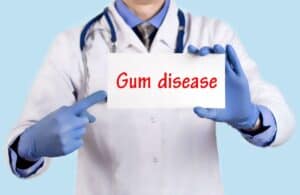Dental Hygiene isn’t just for Your Teeth
 It’s equally as important to take care of your gums, and while the same technique covering tooth-brushing applies to your gums, many people simply don’t take the time to keep their brush moving. One important tip for brushing your gums is to use a soft-bristled brush and brush gently, with circular motions. Brushing too vigorously can weaken the gums, which in turn causes bleeding.
It’s equally as important to take care of your gums, and while the same technique covering tooth-brushing applies to your gums, many people simply don’t take the time to keep their brush moving. One important tip for brushing your gums is to use a soft-bristled brush and brush gently, with circular motions. Brushing too vigorously can weaken the gums, which in turn causes bleeding.
There are two main types of gum disease; gingivitis and periodontitis. Gingivitis is considered to be relatively minor, in part because its most visible symptom are swollen gums. There usually isn’t any pain associated with it, hence many patients may not notice until they’re in the dentist’s chair for a check-up. Gingivitis can be alleviated by practicing good dental hygiene, depending on how advanced it’s gotten. Periodontitis is the advanced form of gingivitis. Swollen gums will start to break down and separate from the teeth, meaning that teeth loss becomes likely. As with gingivitis, symptoms, unfortunately, tend to be either very mild or difficult to self-diagnosis.
It’s clear then that the best way to handle gum disease is to be proactive about not getting it in the first place. Brushing your teeth twice a day is an important first step, but adding flossing and mouthwash into your routine will take it even further. Finally, it’s best to avoid smoking and candy, because both of these things will have an adverse reaction on your teeth and gums. It can be difficult to develop a habit, yes, but it’s much more difficult to sit in a dentist chair and be told that they’ll have to extract your teeth.
Healthy gums are pink in color, are firm and close to your teeth. When you smile, they should be exposed, and there shouldn’t be any bleeding. Give your gums the same attention you give your teeth — it’s easy.
